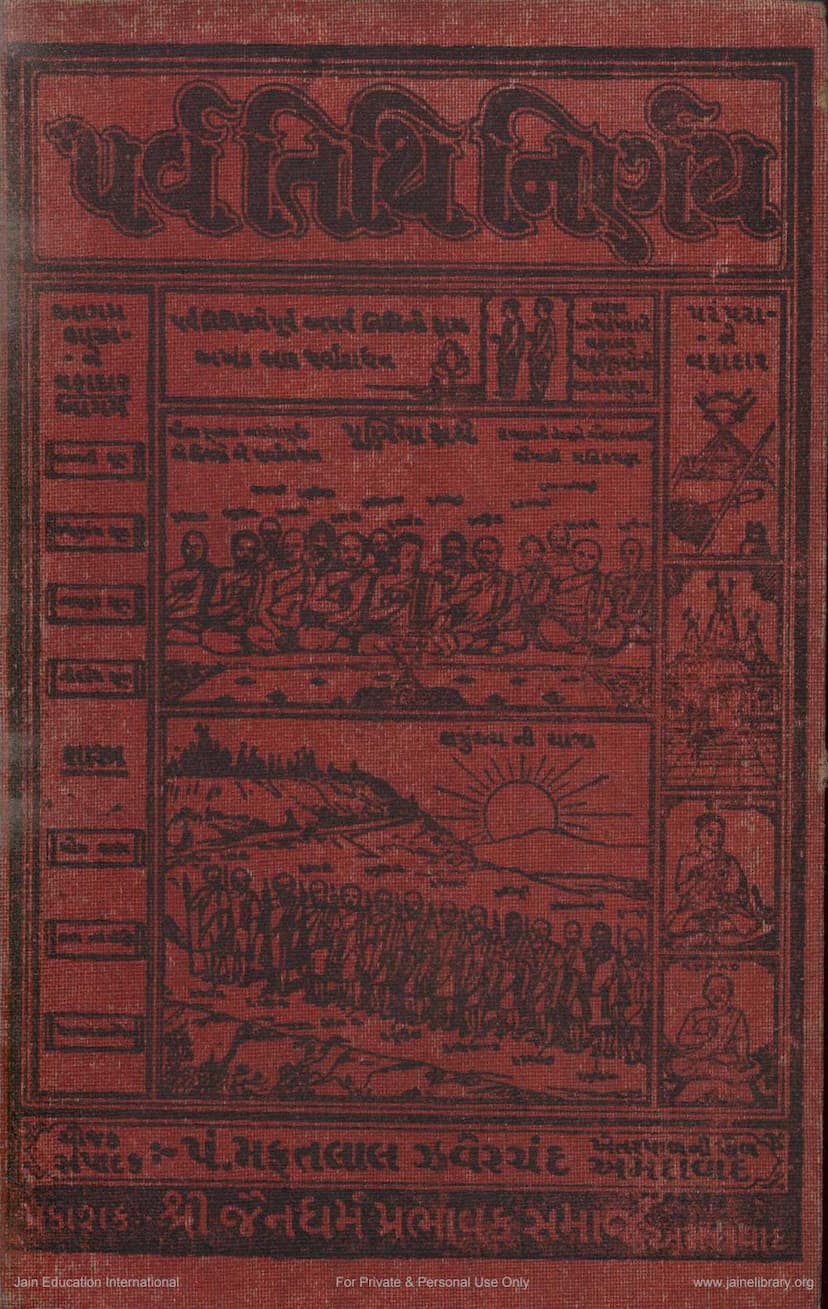Parvatithi Nirnay
Added to library: September 2, 2025

Summary
Here's a comprehensive summary of the Jain text "Parvatithi Nirnay" by Mafatlal Zaverchand Gandhi, based on the provided pages:
Book Title: Parvatithi Nirnay Author: Mafatlal Zaverchand Gandhi Publisher: Jain Dharm Prabhavaka Samaj Ahmedabad Publication Year: V.S. 2001 (1945 CE), Veer Samvat 2471 Catalog Link: https://jainqq.org/explore/001760/1
Overall Purpose and Context:
The book "Parvatithi Nirnay" (Meaning: Decision on Festival Dates/Observances) by Mafatlal Zaverchand Gandhi, published by Jain Dharm Prabhavaka Samaj, Ahmedabad, addresses a significant debate within the Jain community, particularly concerning the correct determination of auspicious dates for religious festivals and observances. The text emphasizes adherence to Jain scriptures, traditions, and the practices of past āchāryas.
The core of the book revolves around a disagreement that arose around V.S. 1992 (1935 CE) and intensified in 1993 (1936 CE) regarding the calculation and observance of festival dates, specifically when there are discrepancies (kshay or vruddhi) in the lunar calendar (tithi). This disagreement led to significant discord within the Jain society, impacting various religious practices and community harmony.
Key Themes and Content:
-
Adherence to Tradition and Scriptures: The book strongly advocates for following the established traditions and interpretations of Jain āgamas and scriptures. It highlights the practices of revered āchāryas and scholars like Vijaydev Suri, Yashovijayji, and Rupvijayji, emphasizing their adherence to the principle of adjusting non-festival days (aparv tithis) to maintain the integrity of festival dates (parv tithis) when tithis were shortened (kshay) or lengthened (vruddhi).
-
The Central Controversy: Tithi Calculation:
- The Established Practice: For centuries, Jain tradition dictated that when a festival tithi (e.g., Panchami, Ashtami, Purnima, Amavasya) experienced kshay (shortening) or vruddhi (lengthening) in the traditional Jain calendar (tithi panchang), the preceding or succeeding non-festival tithi (aparv tithi) would be adjusted. Specifically, when a festival tithi like Chaturdashi or Purnima was affected by kshay or vruddhi, the preceding tithi (like Tritiya for Chaturdashi or Dashami for Ashtami) was adjusted to maintain the festival date. This practice was considered in line with Jain āgamas and scriptures.
- The New Interpretation: The controversy arose when, from V.S. 1992 onwards, Acharya Vijay Ramchandra Suri initiated a new interpretation that aligned festival date calculations with the prevailing secular almanacs (laaukik panchanga). This new approach involved directly observing the kshay or vruddhi of the festival tithi itself, rather than adjusting the preceding or succeeding non-festival tithis. This led to differing observances of festivals like Pakshi, Masik, and Samvatsari, causing significant damage to the Jain tradition and leading to disputes.
-
The Role of Acharya Vijay Ramchandra Suri: The text identifies Acharya Vijay Ramchandra Suri as the proponent of this new tithi interpretation. His actions are described as disrupting the established order, causing discord, and leading to the propagation of "shastraabhas" (misinterpretations or flawed scriptural arguments) through various publications.
-
Efforts Towards Resolution:
- Community Uproar: The differing interpretations caused widespread disharmony, including the disruption of communal events like Swami Vatsalya, Pāranā, and Antarvayanā.
- Mediation Efforts: Recognizing the detrimental impact on the community, prominent individuals in Rajnagar (Ahmedabad) felt the necessity to establish an organization (Jain Dharm Prabhavaka Samaj) in V.S. 1998 (1941 CE) to counter the divisive influence of the new tithi interpretations and to educate the public.
- Arbitration Attempt: An attempt was made to resolve the conflict through arbitration involving respected āchāryas and scholars. Initially, a draft agreement was prepared, but due to non-compliance with the agreed-upon terms, the matter was escalated to a mediator, Dr. P. L. Vaidya.
- Criticism of the Mediator's Decision: The book extensively critiques Dr. P. L. Vaidya's decision. It argues that the decision was flawed, biased, and did not adhere to Jain scriptures or traditions. The author and supporting scholars present detailed analyses, pointing out inconsistencies, misinterpretations, and the failure to consider numerous supporting scriptural evidences. The book includes appended documents and correspondences to substantiate these claims, including letters and statements from various respected āchāryas and scholars who upheld the traditional interpretation.
-
The Author's Stance: Mafatlal Zaverchand Gandhi, through this publication, strongly supports the traditional method of calculating festival dates, emphasizing its scriptural basis and long-standing practice within the community. The book aims to clarify the correct interpretation and preserve the sanctity of Jain traditions.
-
Supporting Evidence: The book relies heavily on:
- References to Ancient Texts: It cites various Jain Āgamas, commentaries, and works of prominent āchāryas and scholars (e.g., Vijaydev Suri, Yashovijayji, Rupvijayji, Nyaayvijayji, Harshsuriji, etc.) to support the traditional practice.
- Historical Practices: It refers to the practices of previous āchāryas and the unbroken tradition of the Devsuri Tapagachha, which historically adjusted non-festival days to maintain the sanctity of festival days.
- Expert Opinions: The book includes opinions and endorsements from numerous contemporary āchāryas and scholars who support the traditional tithi calculation method.
- Analysis of the Mediator's Flaws: Extensive sections are dedicated to dissecting Dr. P. L. Vaidya's arbitration report, highlighting perceived biases and scriptural misinterpretations.
Structure and Key Sections (as indicated by the table of contents):
The book is structured to present a thorough examination of the tithi debate, including:
- Prefatory Statements: Publisher's note, editor's note.
- Arguments from Different Sides: Presentation of points raised by various āchāryas (e.g., Sagarānanandsuri, Vijay Ramchandra Suri).
- Critiques and Rebuttals: Detailed analysis and refutation of Dr. P. L. Vaidya's decision and the arguments presented by the opposing side.
- Supporting Documents: Numerous appendices including oral testimonies, dissenting opinions, refutations of scriptural misinterpretations, correspondences, and historical documents.
- Opinions of Scholars: Inclusion of views from respected pandits and scholars.
- The Author's and Publisher's Stance: Expressing their commitment to upholding Jain traditions.
- A Call for Unity and Righteousness: Encouraging adherence to the established path for the well-being of the Jain faith.
In essence, "Parvatithi Nirnay" is a scholarly and passionate defense of traditional Jain practices regarding festival date calculations, aiming to resolve a significant sectarian dispute by grounding the arguments in scriptural authority, historical precedent, and the consensus of respected āchāryas, while also critically examining and refuting opposing viewpoints.